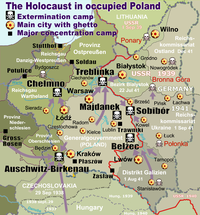It still happens that different media sometimes call them "Polish Concentration Camps".
By doing so they show/prove their great ignorance to the history that Poles and other nations were also victims of German invasion.
In fact, Poland was the first country attacked by Germans in September 1st, 1939 from the west side, and two weeks later, on September 17, 1939 Poland was also attacked by Soviets from the east.
Germans and Russians were cooperating in unison in occupying Poland and killing its citizens during that war for two years, until Hitler decided to attack also Russia in 1941.
In the previous year, Time magazine published a similar expression, but admitted its mistake and published a correction and apologies after protests from the Polish community. A similar situation arose in Canada in 1998, when the Canadian Polish Congress filed a complaint against The Ottawa Citizen, which had used an identical formulation (the complaint was upheld). The principles governing such cases in Australia do not require the publication of a correction, and The Australian did not publish one.

Nazi concentration camps in occupied Poland (marked with black squares)
The German camps in occupied Poland during World War II were built by Nazi Germany during its Occupation of Poland (1939–1945). A system of camps of various kinds was established across the entire country. .......
Extermination camps
The Nazi controlled German government established seven extermination camps (Vernichtungslager) in Poland.
These camps were as follows:
- Auschwitz-Birkenau (Oświęcim, near Kraków)
- Belzec (near the current Ukrainian border north-west of L'viv)
- Kulmhof (Chełmno, between Warsaw and Poznań)
- Majdanek (near Lublin)
- Sobibór (south of Brest-Litovsk)
- Treblinka (north-east of Warsaw)
- Warschau (in Warsaw)
The primary intention of these camps was the extermination of the Jews from all the countries occupied by the Germans, except the Soviet Union (Soviet Jews were generally killed on the spot). Many non-Jewish Poles and other prisoners were also killed in these camps; an estimated 75,000 non-Jewish Poles died at Auschwitz-Birkenau and up to 200,000 at Warschau.
Concentration camps adjoining extermination camps
There were also concentration camps at Auschwitz-Birkenau, Majdanek, Treblinka and Warsaw, distinct from the adjoining extermination camps......
Concentration camps
A concentration camp (Konzentrationslager, KL or KZ) was a camp which was designed to exploit the labor of prisoners, rather than to exterminate them, although the majority of prisoners eventually died from execution, starvation, disease or exhaustion. In Germany before 1939, concentration camps mainly housed Jews and political enemies of the Nazi regime.
There were a number of concentration camps in Poland. They housed Jews, partly as transit points to the extermination camps, and partly so that the Jews could be worked to death. This policy was called Vernichtung durch Arbeit (annihilation through work). Large numbers of non-Jewish Poles were also imprisoned in these camps, as were various prisoners from other countries.Stuthoff was a camp at the beginning designed for extermination of Polish elites.
The major concentration camps in Poland were:
- Kraków-Płaszów (made famous in the book and film Schindler's List)
- Soldau (now Działdowo)
Another camp, Stutthof was in Gdańsk, now in Poland. Another camp, Gross-Rosen (now Rogoźnica) was in German Silesia (now part of Poland), but some of its satellite camps (Aussenlager) to which prisoners were sent to work on various projects, were in Poland. There were also several other concentration camps at:
- Budzyń
- Janowska
- Poniatowa
- Skarżysko-Kamienna
- Starachowice
- Trawniki
Labour camps
The Germans pressed large numbers of Poles into forced labour. These labourers were confined in camps known in German as Polenlager, such as Gorzyce and Gorzyczki, both in Germany and in Poland. One estimate is that there were about 440 of these camps, where at least 1.5 million Poles were set to hard labour. Many of these camps were transient in nature, being opened and closed according to the labour needs of the occupiers.
Many of the 400,000 Polish prisoners of war captured by Germans during the 1939 invasion of Poland were also confined in these camps, although many of them were also sent as forced labourers in Germany.
Several types of labor camps were distinguished by German bureaucracy.
- Arbeitslager was general-purpose term for labor camps in the direct sense.
- Gemeinschaftslager was a work camp for civilians.
- Arbeitserziehungslager were training labor camps, where the inmates were held for several weeks.
- Strafarbeitslager were punitive labor camps, originally created as such, as well as based on prisons.
- The term Zwangsarbeitslager is translated as forced labor camp.
Prisoner of war camps
The Germans established several camps for prisoners of war (POWs) from the western Allied countries in territory which before 1939 had been part of Poland. There was a major POW camp at Toruń (Thorn) and another at Łódź, plus a number of smaller ones. Many prisoners of war from the Soviet Union were also brought to Poland, where most of them died in labor camps. The Germans did not recognise Soviets as POWs and several million of them died in German hands.
Relief for victims
The Polish government has issued a number of decrees, periodically updated providing for the surviving Polish victims of wartime (and post-war) repression, and has produced lists of the various camps where Poles (defined both as citizens of Poland regardless of ethnicity, and persons of Polish ethnicity of other citizenship) were detained either by the Nazis or by the Soviets.


 Platform
for Jewish-Polish Dialogue
Platform
for Jewish-Polish Dialogue